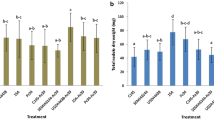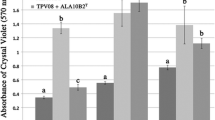Abstract
Symbiotic interactions between peas and Rhizobium leguminosarum were investigated by inoculating four pea lines, three of which are strain-specific resistant to the European strain 311d, with various combinations of two strains of Rhizobium, 311d and Tom++. The strains were almost equally good to infect the susceptible European cultivar Hero when added singly inoculated. After mixed inoculation (1:1 proportion) strain analysis by ELISA revealed that the nodules were preferentially formed by 311d, although some Tom++ nodules were also found mainly on the upper part of the root. Our conclusion is that Tom++ is less compatible in comparison with 311d. In addition, we found that as the Hero plants emerged, they were becoming more resistant towards infection with not adapted bacteria. The strain-specific resistant lines from Afghanistan belong to two different systems: Afgh. I, completely resistant to 311d and highly nodulating with Tom++, and Afgh. III, incompletely resistant to 311d and poorly nodulating with Tom++. Mixed inoculations resulted in nodule depressions, as compared to single inoculations with Tom++ ranging from 87% to 14%. The ability of 311d to block infection sites on the roots were found to depend on the degree of symbiotic adaptation between Afgh. I and Tom++, respectively Afgh. III and Tom++. Strain analysis after double strain inoculation of Afgh. I plants revealed that some nodules were induced by strain 311d. Thus, the presence of Tom++ in this case influences the degree of host resistance. However, in Afgh. III plants the resistance towards nodulation were unaffected by the presence of Tom++. We suggest that the degree of symbiotic adaptation may change the barrier of resistance towards infection.
Similar content being viewed by others
References
Bohlool B B, Kosslak R and Woolfenden R 1984 The ecology of Rhizobium in the rhizosphere: Survival, growth and competition. In Advances in Nitrogen Fixation Research. Eds. C Veeger and W E Newton. pp 287–293. Martinus Nijhoff/Dr W. Junk Publishers, Pudoc, Wageningen, The Netherlands.
Brewin N J, Beringer J E and Johnston A W B 1980 Plasmid-mediated transfer of host-range specificity between two strains of Rhizobium leguminosarum. J. Gen. Microbiol. 120, 413–420.
Bromfield E S P and Jones D G 1980 Studies on double occupancy of nodules and the competitive ability of Rhizobium trifolii on red and white clover grown in soil and agar. Ann. Appl. Biol. 94, 51–59.
Broughton W J, Samrey U and Bohlool B B 1982 Competition for nodulation of Pisum sativum cv. Afghanistan requires live rhizobia and a plant component. Can. J. Microbiol. 28, 162–168.
Broughton W J, vanEgeraat A W S M and Lie T A 1980 Dynamics of Rhizobium competition for nodulation of Pisum sativum cv. Afghanistan. Can. J. Microbiol. 26, 562–565.
Devine T E, Kuykendall L D and Breithaupt B H 1980 Nodulation of soybeans carrying the nodulation-restrictive gene, rj t, by an incompatible Rhizobium japonicum strain upon mixed inoculation with a compatible strain. Can. J. Microbiol. 26, 179–182.
Dowling D N and Broughton W J 1986 Competition for nodulation of legumes. Annu. Rev. Microbiol. 40, 131–157.
Dowling D N, Samrey U, Stanly J and Broughton W J 1987 Cloning of Rhizobium leguminosarum genes for competitive nodulation blocking on peas. J. Bacteriol. 169, 1345–1348.
Gibson A H 1968 Nodulation failure in Trifolium subterraneum L. cv. Woogenellup (syn. Marrar). Aust. J. Agric. Res. 19, 907–918.
Kosslak R M, Bohlool B B, Dowdle S and Sadowsky M J 1983 Competition of Rhizobium japonicum strains in early stages of soybean nodulation. Appl. Environ. Microbiol. 46, 870–873.
Lie T A 1978 Symbiotic specialisation in pea plants: The requirement of specific Rhizobium strains for peas from Afghanistan. Ann. Appl. Biol. 88, 462–465.
Lie T A 1984 Host genes in Pisum sativum L. conferring resistance to European Rhizobium leguminosarum strains. Plant and Soil 82, 415–425.
Lie T A, Göktan D, Engin M, Pijnenborg J and Anlarsal E 1987 Co-evolution of the legume-Rhizobium association. Plant and Soil 100, 171–181.
Lie T A, Winarno R and Timmermans P C J M 1978 Rhizobium strains isolated from wild and cultivated legumes: Suppression of nodulation by a non-nodulating Rhizobium strain. In Microbial Ecology. Eds. M W Loutit and J A R Miles. pp 398–401. Springer-Verlag, Berlin, Heidelberg.
Mårtensson A M, Gustafsson J-G and Ljunggren H D 1984 A modified, highly sensitive enzyme-like immunosorbent assay (ELISA) for Rhizobium meliloti strain identification. J. Gen. Microbiol. 130, 247–153.
Ohlendorf H 1983a Selektion auf Resistenz von Pisum sativum gegen Rhizobium leguminosarum Stamm 311d. Z. Pflanzenzücht. 90, 204–221.
Ohlendorf H 1983b Untersuchungen zur Vererbung der Resistenz von Pisum sativum gegen Rhizobium leguminosarum Stamm 311d. Z. Pflanzenzücht. 91, 13–24.
Ohlendorf H 1986 Symbiotic interactions between the effective Rhizobium leguminosarum strains 311d and Tom++ and strain-specific resistant (311d) pea lines. Angew. Bot. 60, 175–186.
Rolfe B G and Gresshoff P M 1980 Rhizobium trifolii mutant interactions during the establishment of nodulation in white clover. Aust. J. Biol. Sci. 33, 491–504.
Rolfe B G, Gresshoff P M, Shine J and Vincent J M 1980 Interaction between a non-nodulating and an ineffective mutant of Rhizobium trifolii resulting in effective (nitrogenfixing) nodulation. Appl. Environ. Microbiol. 39, 449–452.
Singleton P W and Stockinger K R 1983 Compensation against ineffective nodulation in soybean. Crop Sci. 23, 69–72.
Winarno R and Lie T A 1979 Competition between Rhizobium strains in nodule formation: Interaction between nodulating and non-nodulating strains. Plant and Soil 51, 135–142.
Author information
Authors and Affiliations
Rights and permissions
About this article
Cite this article
Ohlendorf, H., Mårtensson, A.M. Studies on the nodulation of strain-specific resistant pea lines using single, mixed and delayed inoculation by Rhizobium leguminosarum . Plant Soil 121, 235–242 (1990). https://doi.org/10.1007/BF00012317
Received:
Issue Date:
DOI: https://doi.org/10.1007/BF00012317




